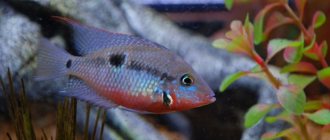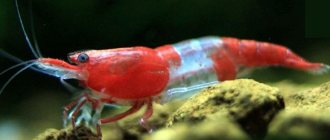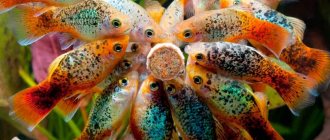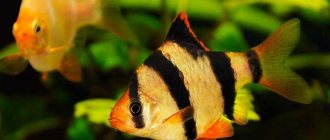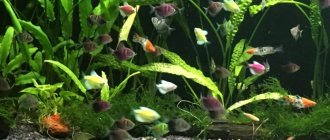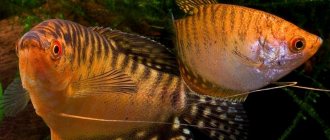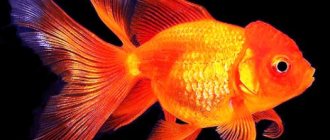Non-communicable diseases
Non-communicable diseases are most often caused by unfavorable living conditions or various damages and injuries. The cause may be poor quality food, gas poisoning, lack of oxygen, sudden changes in temperature.
Asphyxia (suffocation, death)
Asphyxia is a condition that occurs due to lack of oxygen. The consequence of asphyxia can be death.
Causes. Asphyxia occurs in an overcrowded pool with insufficient oxygen, at too high temperatures, as a result of rotting dead fish and food residues that are not removed from the “dwelling” in time.
Symptoms The fish rise en masse to the surface of the water and actively swallow air, which continues for several hours. Individuals have protruding gills.
Treatment. Initially, the cause of asphyxia is eliminated. Next, part of the water is changed and aeration is carried out. If this is not possible, temporary assistance can be provided with a 15% solution of hydrogen peroxide at a rate of 1 g/l. This product cannot be reused as the fish may die.
Acidemia
Associated with high ammonia content. This is a waste product of fish, even in small quantities it becomes poisonous to individuals.
Causes. When the amount of ammonia in water increases, an alkaline reaction occurs. The cause of acidemia is the rare replacement of water with fresh water, as well as overcrowding of the pool, and the accumulation of decaying organic matter.
Symptoms The color of the fish darkens, they stay on the surface of the water due to lack of oxygen, sometimes they strive to jump out of the pond/pool or tank. The gills may be damaged.
Treatment. Treatment begins with partial water replacement/renewal, which will help save the fish. If there are many individuals in the reservoir, it is recommended to install an additional filter and turn on the compressor. For prevention, it is advisable to balance the amount of food, fish and the size of the pool. Immediately remove food debris and dead fish from the container.
Alkali disease (alkalosis)
Alkalosis is associated with an increase in the level of acidity of the environment. The consequence is dullness of the skin of the fish and the secretion of mucus from the gills.
Causes. In a tank with soft, acidic water, densely planted with plants and intense sunlight, there is a risk of a sharp jump in acidity levels. Long-term exposure of fish to such an environment can cause alkalosis.
Symptoms The inhabitants of the reservoir begin to breathe faster, they begin to spread their fins and rush around the container. Coordination disturbances and convulsions are noticeable. The fish are trying to jump out of the water.
Treatment. Immediately after the disease is established, the fish are transplanted into a pool with a hydrogen index of 7.5-8. In a pool with a high acidity level, the value is gradually brought to an optimally low level. It will be possible to achieve the desired indicators using a special pH buffer.
Shock in fish
This is the body's physiological response to sudden shocks of various types. Shock usually occurs when one or more environmental factors (in particular, temperature or water chemistry) change too sharply.
Causes. Shock is usually observed in fish that have just been released into a pool/pond, but often such an illness manifests itself due to a partial water change/change if attention is not paid to this parameter.
Symptoms The color intensity decreases, fish hide among plants or other objects, individuals have accelerated or slowed breathing, and they periodically move abruptly to another place.
Treatment. If shock begins quickly and clearly, the cause is initially determined, and then treatment begins. If all the inhabitants of the reservoir are affected, the conditions in it are changed. If recently released fish have been subjected to shock, they are transferred to more suitable conditions (water with familiar parameters).
Gas bubble disease (gas embolism)
During a gas embolism, the fish begins to behave timidly: lose coordination if the eyes are damaged, swim on its side. This indicates the need to urgently take certain measures.
Causes. Unsettled water used to fill a pool or pond. It contains many air bubbles, leading to gas embolism. Another reason is considered to be excessive pool aeration. A large number of plants with too intense lighting can result in excessive saturation of the “dwelling” with oxygen.
Symptoms It appears in the form of bubbles on the body and eyes of the fish. Bubbles can also appear on the internal organs of the fish, which can be fatal in 60-80% of cases. The fish is lethargic and refuses food. The fins begin to twitch convulsively, the gills move less frequently, the eyes become cloudy, and coordination of movements is impaired.
Treatment. The method of settling the supplied water in intermediate basins with minimal water movement will help eliminate excess gases dissolved in water. After 18-24 hours, the gas regime is completely normalized.
Colds
Keeping fish in water temperatures that are unacceptable for them for a long time leads to colds, which reduces the activity of the fish and causes them to float on the surface.
Causes. Occurs due to keeping fish in colder water than is permissible. Typically, warm-water fish are kept in water at a temperature of 22-27 degrees, cold-water fish - 18-22 degrees.
Symptoms Individuals with a cold become dark, sallow, their gill filaments swell and darken, growth slows down, and dystrophic changes are observed in the internal organs. Because of this, fish produce immature eggs and milk. The fry are dying.
Treatment. Infected individuals are given normal conditions by raising the temperature to an optimal level. The water is pumped with oxygen and disinfectants are used.
Obesity
If fish are obese, they may have difficulty moving. Obesity is accompanied by invisible internal problems: digestive tract disorder and functional infertility, which occurs as a result of the formation of fatty deposits around the gonads, and a liver swollen with fat.
Causes. Highly nutritious food, in which the fat content for plant animals is more than 3%, and for carnivores 5%. Obesity also occurs when fish are overfed, improperly or monotonously fed, including dry food. A common cause is a crowded pond or pool where fish cannot swim freely and lose calories.
Symptoms Large body girth in the abdominal area, as well as the area between the head and abdominal region.
Treatment. A therapeutic diet and a strict feeding regime will help to cope with the problem. It will do no harm to the fish to reduce its food intake to an absolute minimum until its body returns to what nature intended.
Gonadal cyst
A gonadal cyst occurs when fish are separated by sex. It occurs chronically, which is why it is discovered late, when the milk or caviar has already succumbed to changes.
Causes. Long-term keeping of females and males separately, excessive feeding of dry food.
Symptoms The belly increases greatly, because it contains a lot of liquid or mushy contents. This causes strong pressure on the genitals of the fish, which leads to disruption of functions and metabolic processes in the body as a whole. The advanced form is fraught with the death of the fish - the cyst ruptures.
Treatment. It is treated only at the initial stage. To do this, place the fish belly up in cotton wool moistened with water and gently stroke it from the pectoral fins to the caudal fin - this is how the contents of the tumor are squeezed out. Such actions help to achieve a positive result.
Inflammation of the gastrointestinal tract
This is a common problem seen in fish. Dry food is poorly digestible and causes inflammation of the mucous membrane of the gastrointestinal tract of fish.
Causes. Fish caught in the wastewater of a reservoir are introduced into a pool or artificial pond, fed with dry daphnia, gamarus, and bloodworms. Fish also suffer from inflammation of the gastrointestinal tract due to consumption of low-quality food.
Symptoms The fish eat well, but seem lethargic. Their skin darkens and their belly enlarges slightly. Inflammation of the intestines is also indicated by redness of the anus, thread-like stool with bloody mucus.
Treatment. Inflammation is treated simply: the fish are transferred to a varied, complete feeding of live hydrobiopts. It is undesirable to obtain live food in reservoirs that receive wastewater from domestic and industrial enterprises.
Varieties
If the natural variety is dark silver, then the artificial ones obtained as a result of breeding work are varied in color, size and shape of fins:
- voile;
The most common classic species in the domestic aquarium hobby are caramel thorn and glofish.
Ternetsia caramel
This is the name of a variety of characia fish, painted in bright colors by introducing special coloring solutions. This color quickly “wears out” and “fades”.
Ternetia glofish
This is a recently bred variety, obtained through genetic modification and is distinguished by its bright multi-colored fluorescent color, which does not fade and is inherited by offspring. The colors of scales and fins can be different - azure, turquoise, lemon, scarlet, sky blue, purple, orange and pink.
Parasitic diseases
Ichthyopathological examination of fish living in reservoirs and ponds of fish farms usually shows the presence of numerous parasitic organisms. With a small population, the fish practically does not suffer, but with many parasites there is a risk of contracting a parasitic disease.
Chylodonellosis
Invasive disease of freshwater fish. In pond fish farming, it affects young fish weakened by wintering. But chilodonellosis often occurs in warm-water ponds.
Causes. Chilodonellosis, externally manifested in the formation of coarse-grained formations of a gray-blue hue from mucus, at the initial stage of development of the disease is noticeable only from a certain angle of view, is caused by three species of ciliates from the genus Chilodonella - Ch. hexasticha, Ch. cyprini (piscicola) and Ch. uncinata.
Symptoms Infected individuals begin to rub against stones and plants and press their fins. Occasionally, appetite decreases. When examined, when the fish is positioned upside down, a bluish-matte coating can be seen along the lateral line. Sometimes the skin comes off in patches. Often, infection of the gills provokes mass death of fish.
Treatment. Before treatment begins, the fish are kept at a temperature of 30-32 degrees, which helps restore strength. If symptoms are noticed at a stage when the fish do not refuse food, it is not necessary to follow the recommendation. Treatment will be effective simultaneously with the use of a reduced dosage of Sera Mycopur. Chylodonellosis is also treated with antibiotics.
Dactylogyrosis
An invasive disease caused by monogenetic flukes. About 150 species of monogenea are known.
Causes. The causative agent of dactylogyrosis is a fluke from the genus Dactylogyrus, which has an elongated body.
Symptoms Fish infected with the parasite lose their appetite, stay near the surface, greedily swallow air, and rub against objects. The animal develops a thick layer of mucus on its gills, resembling a mosaic. The gill filaments are fused.
Treatment . Infected individuals are transferred to a quarantine pool, where a 0.2% ammonia solution is first added at the rate of 2 ml per 1 liter of water. To treat fry in nursery and fry ponds, chlorophos solutions are used (the drug is added at the rate of 0.6-1 g per cubic meter of water). In a common tank, larvae without fish will die within 24 hours. When purchasing new individuals, they are quarantined. Disinfect the container with a baking soda solution.
Trichodinosis
An illness during which fish suffer from loss of appetite, their breathing becomes rapid, and their reactions completely slow down. The fish die by turning over on their side.
Causes. Trichodinosis occurs due to ciliated ciliates; it has a round body shape and a reddish tint. The parasite lives on the skin and gills. The artificial pond comes from a natural reservoir where fish live, with soil and plants.
Symptoms The body of infected individuals is covered with grayish-matte mucus, which prevents the fish from breathing normally. In the initial period, the fish become restless and constantly swim to the surface of the water to swallow air. The gills also have a thick layer of mucus.
Treatment. Aerate by adding methylene blue. In an empty pond without fish, ciliates die in 2-3 days. Organic dyes, sea water, solutions of active chlorine and table salt are used as medicinal preparations. Treatments are carried out after 24-48 hours. Only 3-4 treatments. For prevention, it is necessary to observe hygienic measures, move new individuals to quarantine before moving in with other fish.
Gyrodactylosis
Infection with hydrodactylosis can lead to the death of fish in a public pool within a week. With such a disease, fish lose their appetite, and a coating appears on the skin and gills.
Causes. Caused by monogenetic flukes Gyrodactylus from the family of the class Monogenea.
Gyrodactylus flukes under a high magnification microscope
Symptoms Affected fish wobble and float on the surface of the water, with their fins tightly compressed. As the disease progresses, the fish begin to rub against objects. Separate blue or gray areas appear on the surface of the body, the eyes become cloudy, and a coating forms on the gills.
Treatment. For treatment, salt baths are used from a 5% solution of table salt with an exposure of 5 minutes. In winter, it is permissible to add purple “K” to ponds at the rate of 0.2 g per cubic meter. m. For preventive purposes, they follow the rules of hygiene and regularly disinfect the tank. Before placing fish for spawning for 24 hours, it is necessary to treat the pool with a solution of table salt.
Glucose
The causative agent is sporozoans - they colonize on tissues, internal organs, and gills. When they enter the body, they mate, forming white nodes that appear on the body of the fish.
Causes. The parasite can enter the pond along with sick fish when the disease is only at the initial stage. Fish of the carp family are especially susceptible to glutenosis.
Symptoms Accompanied by bloody spots turning into ulcers, one-sided or two-sided bulging eyes, knob-like protrusions on the fish’s body, and swimming on its side.
Treatment. Today there is no way to get rid of the problem. If glutenosis is established, it is advisable to get rid of all plants and fish contained in the pond.
Lerneosis
During lerneosis, sick fish are exhausted, refuse food, lose mobility, accumulate on the water flow and die.
Causes. This is an invasive disease of freshwater fish caused by the copepod Lernaea cyprinacea from the family. Lernaeidae, parasitic on the body of individuals.
Symptoms Parasites penetrate the skin and reach muscle tissue, penetrating deeply into it, located on the entire surface of the body. In places where the crustacean invades the tissue, an inflammatory process occurs: swelling, hyperemia, leading to the formation of ulcers. The scales not only become deformed and rise, but also fall out.
Lerna copepods attached to fish
Treatment. Lerneosis is difficult to treat. Various drugs and various treatment methods are used. For sick fish, it is recommended to prepare a quarantine pool with optimal conditions and add a solution of table salt to it at the rate of about 20 g of salt per 10 liters of water. The fish are kept in this solution until complete recovery and wound healing.
Octomitosis (hexamitosis)
This is a parasitic disease that negatively affects the gallbladder and intestines. Externally, it is easily determined by the presence of holes, ulcers and furrows. For this reason, hexamitosis is also called “hole” disease.
Causes. Failure to comply with basic conditions for caring for the inhabitants of a tank or pond. These include a lack of minerals or vitamin deficiency (which leads to decreased immunity), infrequent or excessive feeding, and the use of low-quality or spoiled food.
Symptoms The fish lose their appetite, they become picky when eating, and white mucous discharge appears. The belly also swells, the fins collapse and fall off, deep erosions appear on the sides of the fish’s body, and the anus enlarges.
Treatment. Initially, infected fish are moved to a quarantine pool, which will prevent the development of the disease in a common vessel. After this, in a separate container (quarantine) the water temperature is increased to 34-35 degrees - this contributes to a detrimental effect on some parasites and leads to their death.
Ichthyophthiriasis (“semolina”)
All species of fish are affected. It is popularly called “manna disease” due to the formation of white grains on the fins and scales of fish.
Causes. The causative agent is ciliated ciliate. The parasite is highly adaptable.
Symptoms The fish breathe frequently, begin to itch against objects and hard surfaces, and subsequently suffer from a white coating in the form of grains.
Treatment. Quarantine is recommended as a preventive measure - newcomers should not be immediately released into a common pond. For treatment, it is permissible to add salt to the water and raise its temperature - the parasite does not tolerate a salty environment and an increase in the temperature level of the water. Bactericidal drugs are also used to combat ichthyophthyriasis.
Treatment: saprolegniosis
Saprolegniosis affects the gills, eyes, fins and skin. In the initial stages, a white coating similar to cotton wool appears on the skin of individuals, and in advanced stages it is accompanied by redness, bruising and mucus secretion (Figure 4).
Figure 4. Symptoms of saprolegniosis
Saprolegniosis is best treated in the early stages using potassium permanganate lotions. Alternatively, you can dip the fish in a saline solution for five minutes (50 grams of salt per liter of water).
Bacterial diseases
The development of infectious diseases is provoked by various pathogenic bacteria. Depending on the type of disease, certain disturbances in the behavior or well-being of the fish appear. To diagnose the disease and prescribe timely treatment, you need to know certain signs of common infections.
Mycobacteriosis (tuberculosis)
Viviparous fish species suffer from mycobacteriosis. Their behavior changes and their appetite disappears.
Causes. Transported with food, plants or soil. With fish and shellfish. There are cases where the cause of mycobacteriosis was insects that flew in to drink water. Improper living conditions and weakened immunity lead to the development of mycobacteriosis.
Symptoms Fish become lethargic, their eyes bulge, they lose orientation, and some go blind. Animals also suffer from ulcers, tears, blindness, and apathy.
Treatment. It is carried out at an early stage: for this it is recommended to use Monocycline, Tripoflavin, copper sulfate.
Aeromonosis (carp rubella)
A bacterial infection of cyprinids, when scales are ruffled over the entire surface of the fish’s body, begins to fall out. Treatment can lead to recovery or death of the individual.
Causes. Aeromonosis is introduced into artificial ponds and pools from natural reservoirs, when fish that have not passed quarantine are introduced into soil, vegetation, and water. The infection spreads due to poorly disinfected equipment and tools.
Symptoms In the acute course of the disease, fish die en masse. Serous-hemorrhagic inflammation of the skin, hydremia of organ tissues and muscles appear on the belly, fins, and side walls of the body. In the chronic course, open and scarring ulcers form, accompanied by anemia of the liver and swelling of the kidneys.
Treatment. Aeromonosis is treatable only at the initial stage. Fish with abdominal dropsy and raised scales are destroyed. Externally healthy fish must be processed by immersing them in a separate vessel using basic violet K (Chlorohydrite, a synthetic dye); Bicillin-5 or soluble white streptocide is poured into the general tank at the rate of 15 g per 100 liters of water.
Salmon furunculosis
Furunculosis is an infection characterized by septicemia, the formation of boils in muscle tissue followed by rupture and their development into reddish ulcers.
Causes. The causative agent of furunculosis is the bacterium Aeromonas salmonicida.
Symptoms When infected with furunculosis, fish exhibit spotted hemorrhages of various sizes and shapes, the belly becomes enlarged, the eyes bulge, and ruffled scales appear in certain areas or throughout the body. Inflamed fins often have a blood-red hue.
Treatment. To prevent furunculosis, it is necessary to prevent the introduction of the pathogen with water, fishing gear, caviar, fish and other aquatic organisms. For prevention, it is recommended to treat caviar with solutions of Acriflavine or Merthiolate. The further spread of furunculosis will be avoided by the developed complex of treatment and preventive measures: caviar is treated with acriflavine, iodinol or formaldehyde. To treat sick fish, they are fed food with the addition of sulfonamide drugs at the rate of 120 mg per 1 kg of fish weight for 14 days.
Bacterial fin rot
With this disease, the fin of the fish disappears. Ulcers appear at its base, the spinal column is exposed, this leads to death.
Causes. Occurs due to an infection that destroys the fins of fish. The causative agent is a rod. The development of fin rot is provoked by non-compliance with care rules, rare changes or purification of water in a pond or pool.
Symptoms . At the beginning of the disease, a slight clouding of the color of a bluish-white hue appears on the edges of the fins. The fins are disheveled at the edges, the ends of their rays gradually fall off.
Treatment. They fight radically. Initially, the conditions for keeping fish are improved. If the fins are severely damaged, you cannot do without the use of medications. The pool is regularly disinfected.
Lepidorthosis (infectious ruffling of scales)
Lepidorthosis progresses slowly. After it, the fish die, but with timely treatment it will be possible to achieve a successful outcome.
Causes. The causative agents are bacteria that enter an artificial pond from a reservoir where there are fish with food.
Symptoms At the initial stage, affected individuals suffer from ruffled scales in some areas. Gradually the phenomenon spreads to the whole body. Soon the scales begin to fall out, which leads to death.
Treatment. Treatment of infected fish is acceptable at the initial stage. It is recommended to carry out medicinal baths with the drug Biomycin or Bicillin-5. When treating in a separate vessel, it is permissible to use basic violet K. If the therapy does not bring results, the fish are killed, and the pool and other equipment are disinfected.
Pseudomonosis (peptic ulcer)
Symptoms develop rapidly. In most cases, peptic ulcer disease leads to the death of fish.
Causes. Caused by bacteria entering the pool with food or from sick relatives. Sources of pathogenic pathogens include poorly settled water. The bacteria may end up in the container from a person’s hands.
Symptoms Accompanied by the appearance of dark spots on the skin of the fish, they gradually turn into ulcers. Also, the belly of the fish becomes larger, the eyes bulge, the appetite decreases, and the scales become ruffled. The infection enters the body.
Treatment. It is necessary to start treatment in a timely manner. To combat, use streptocide, dissolving one tablet in 10 liters of water. They also treat fish with potassium permanganate, dissolving it directly in the pool - 5 g of solution per 10 liters of water. The fish should swim in this solution for about 20 minutes, then take in clean water.
White-skinned (Pseudomonas dermoalba)
An infectious, serious disease that negatively affects the fish’s body, and therefore requires good treatment immediately after the first symptoms are detected.
Causes. Damage to the fish body by a pathogenic bacterium, which can enter the pond from a natural reservoir along with sick fish, soil and plants.
Symptoms There is whitening of the skin in the area of the dorsal fin and tail. The fish stays close to the surface, often exposing its fin. The color turns white. Lack of treatment may be accompanied by damage to the central nervous system and organs responsible for coordinating movement. This can be fatal.
Treatment. It can be prevented by following basic hygiene rules. Affected fish are moved to another container for quarantine. Dissolve 150-200 mg of Levomycetin in 1 liter of water, pour the composition into a pond with sick fish. They are kept in such conditions for at least 5 days.
Disease Prevention
Most aquarium fish diseases can be easily prevented if preventative measures are taken regularly.
Disease prevention includes:
- Disinfection of new objects and plants that are placed in the aquarium;
- Checking the temperature, pH, oxygen level of the water in the aquarium;
- Replace water as it gets dirty;
- Providing fresh and varied food for fish;
- Acquiring healthy new individuals for the aquarium;
- Timely diagnosis and treatment of diseases in fish.
Fish diseases arise as a result of improper care of pets, the appearance of infected individuals, plants or decorative items in the aquarium.
To prevent the development of problems, it is necessary to monitor the purity of the water, maintain the temperature regime, and regularly inspect the pets. It is important to be attentive to new fish that have skin irregularities or growths. They are often the source of diseases.
Mycotic diseases of fish
Fish suffer from mycotic diseases due to the formation of fungi. They are multicellular or unicellular, non-chlorophyll-containing organisms belonging to lower plants.
Branchiomycosis
This is a fungus that affects the gill apparatus of fish. The causative agent of branchiomycosis is Branchiomyces demigrans and Branchiomyces sanguinis.
Causes. Fungi settle on the gill filaments. All fish species kept in improper conditions can suffer from the disease. The disease develops due to high water temperature and organic compounds of dead plants. The disease is developing rapidly.
Symptoms. Sick fish do not have enough oxygen, pinpoint hemorrhages are visible on the gill leaves, and deformation of the gill covers occurs. The fish refuse food and swim at the surface of the water all the time, scooping up air with their mouths. Bright red and pale spots become visible on the gills.
Gill rot
Treatment. When the first signs appear, all fish are transferred to a quarantine tank and treated with malachite green oxalate, and the observation tank is cleaned and disinfected. Maintaining cleanliness and hygiene in the pool will help to avoid branchiomycosis.
Ichthyophonosis
A dangerous mycotic disease of pond and aquarium fish. Caused presumably by an imperfect fungus from the class Phycomycetes.
Causes. The causative agent is Ichtyophonus hoferi, which has a round or ovoid shape. A capsule is formed around the fungus, secreted by the affected organ. Hyphae are also observed in the form of blunt outgrowths that develop into an independent round body.
Symptoms. The pathogen spreads hematogenously to various organs and tissues, where inflammation first develops, then encapsulation of the affected areas occurs. When functions are impaired, the fish stops responding to stimuli, its movement becomes erratic and sluggish. She stays off the coast. When the liver and kidneys are damaged, bulging eyes, ruffling of scales, and ascites are observed. Localization of the pathogen in the subcutaneous tissue, muscles and eyes leads to knobby swellings and ulcers, black spots on the skin.
Treatment. Not developed. But they must control the process of transporting fish. Be sure to feed fish with marine relatives only after heat treatment. Also, for preventive purposes, it is advisable to promptly disinfect ponds with quicklime or bleach.
Saprolegniosis ("cotton wool disease")
A mycotic disease of most fish species caused by opportunistic aquatic fungi from the class Oomycetes. More often this is a secondary disease; first, injured areas of the body or damaged eggs are affected, then the disease spreads to healthy areas and eggs.
Causes. The causative agents of the disease are representatives of the genera Achlya and Saprolegnia. The mycelium of these fungi is formed by hyphae having a limited number of transverse partitions.
Symptoms. The most characteristic sign of the disease is cotton wool-like, fluffy white growths on the caudal and dorsal fins, head, olfactory pits, eyes and gills. Before the death of the fish, a loss of balance was noticed.
Treatment. In summer and autumn, for prevention, it is recommended to treat fish twice with basic violet K at the rate of 1 g per cubic meter. m of water for half an hour. 0.1% salt baths for 30 minutes are also suitable. To combat the disease, the water supplied to the hatchery is disinfected with ultraviolet rays.
Treatment of ichthyophthyriosis
The disease is caused by a parasite that lives in freshwater bodies. The ciliate parasite is constantly in the host’s body, releasing cells into the water (Figure 5). Gradually all individuals become infected. A favorable temperature for the development of the parasite is 25-26 degrees.
Figure 5. Signs and mechanism of infection with ichthyophthyriasis
Severe infestation causes loss of the top layer of skin; the individual strives to get to the influx of water, but gradually suffocates and dies. It is difficult to combat ichthyophthyriasis, since the parasite lives directly under the skin. Therefore, it is better to take effective preventive measures in advance. To do this, you need to keep adults and juveniles separately, regularly drain the pond bed and destroy the parasite larvae floating freely in the water (vagrant stage). To do this, add table salt to the water. The length of stay in salt water depends on the temperature: the higher it is, the shorter the stay. Such salt baths are absolutely safe for fish, and if the technology is followed, they lead to complete recovery.
Symptoms of diseases
Often, with certain diseases, certain symptoms arise, based on which it is possible to make a timely diagnosis and begin treatment of the disease in order to save the fish.
Bug-eyed
With this disease, the eyes become very swollen and often fall out completely. This symptom occurs during infectious infection, for example, with ichthyosporidosis, mycobacteriosis, etc. The method of treatment directly depends on this.
Causes. Bug eyes can occur due to infection of fish by viruses, bacteria or fungi. Along with this, provocateurs include physiological failures, trematodes, eye nematodes (worms), and lack of vitamins (beriberi).
Symptoms Cloudiness of the entire eye, the appearance of a whitish film, the eye moving away from the body. Advanced cases lead to the loss of one or both eyes.
Treatment. If bulging eyes are caused by a bacterial infection, it is initially treated using antibiotics and adding them to food. If a problem arises due to unsuitable living conditions, they begin by eliminating them: the water is regularly purified, the fish are fed in a balanced manner.
Bloating
Dropsy is accompanied by severe bloating and puffy scales. The fish becomes lethargic and breathes heavily.
Causes. Causes of abdominal enlargement include mycobacteriosis, aeromonosis, and nocardiosis. In addition to bacteria, a virus (spring viremia) can cause bloating. With gonadal cysts, an increase in the abdomen of females is also observed.
Symptoms A swollen abdomen, transparent skin due to a strong increase in the abdomen, curvature of the spine.
Treatment. The fish is immediately removed, observed and inspected. Fish are treated depending on the causes of abdominal enlargement, but most often the fish dies if the abdominal distension is caused by a bacterial infection.
If you learn to recognize the causes and symptoms of diseases, you will be able to prevent them or cope with ailments using effective methods. Following simple hygiene rules, frequent changes of water, and feeding fish with high-quality food will reduce the risk of infection in fish bred in natural or artificial conditions.
0
0
Copy link
Description of the species
The fish belongs to the characin family. It is non-aggressive and does not require too much care. Thorns have a flat silver body with three black stripes running across it. The anal fin is distinguished by its black color and veil shape. The remaining fins are transparent. The length of the thorns varies from 4 to 5 cm. Moreover, females are much larger than males. The fish have a timid character. If any danger is detected, they can change color to a lighter one and hide in a secluded place.
In this video you will learn more about these fish:
The first mention of this species of fish dates back to 1895. Only in 1933 did they appear in Europe, and were brought to Russia much later - in 1946. In the wild, fish are found quite often. They are common in Brazil and Bolivia. The most popular habitats are the Mato Grosso and Rio Paraguay rivers.
Ternetia fish choose bodies of water with dense vegetation, which is why experts recommend decorating the aquarium with algae around the edges and leaving a free area for swimming in the center. When breeding thorns at home, it should be taken into account that they get along well with:
- gourami;
- scalars;
- swordtails;
- large tetras;
- pouchbranch catfish;
- Corydoratuses.
Ternetias are not compatible with neons, guppies, cichlasomas, astronotuses and other predatory fish, since they cannot get along with them.
By aquarium standards, thornets have an average lifespan. With proper care, their life span can last up to 6 years. The average duration varies from 3 to 4 years.
There are several varieties of these fish. Individuals of natural origin have a common dark gray color. Other varieties have been bred through selective breeding. So, there are colored thorns of gold and white color. Breeders also managed to develop pink thorn (caramel).
Recently, multi-colored fish bred using the Glo-fish technology have become especially popular. For an aquarium, you can purchase Trenetius in different colors: light green, blue, orange, blackberry, mint, red or purple. But all of them were released relatively recently - in 2011.
Advantages and disadvantages of ternations
An undoubted advantage for breeding these fish is their ease of care, resistance to diseases and omnivorousness. In addition, the high degree of peacefulness and friendliness allows you to add almost any freshwater species to them.
The disadvantages of thorns include their high mobility. Slow neighbors often begin to irritate them, which results in tugging at the fins of the red-tailed species and pinching and biting of their sedate counterparts.
Ternetias have good resistance to various diseases, but poor care and improper maintenance conditions negatively affect their health.
The owner needs not only to know how to cure fish from a particular disease, but also to understand what caused the unpleasant misfortune.
Lerneosis
Lerneosis is an invasive fish disease caused by parasitic crustaceans of the genus Lernaca. It is observed when growing fish in ponds and aquariums. The causative agent of lerneosis is L. cyprinacea and l. elegans, parasitizes herbivorous fish with L. ctenopharyngodnis, in carnivores - l. esocina. The crustaceans settle on the skin, fins, nasal pits, eye sockets, mouth and gill cavities of fish.
With a population of 10-15 specimens/p.z. cause anxiety in fish, increased sliming of the integument, and a bluish or gray coating appears on the body of the fish. The diagnosis is made after microscopy of scrapings. Treatment is selected taking into account environmental conditions and the condition of the fish. There are several effective drugs, which include malachite green, brilliant green, violet “K”, potassium permanganate, table salt, formaldehyde solution, etc.
Breeding
Sexual maturity occurs in thornets at 6-8 months, when individuals reach a length of 3-4 cm. Females differ from males in a wider and more massive body with a dense belly.
Before mating and breeding, the fish are fed intensively for 2-3 weeks. Then they are deposited in a spawning tank, planted with aquatic plants with small leaves, with warm, soft and acidic water, and dark soil. Its volume must be at least 30 liters.
To dim the light, the front wall can be covered with a sheet of paper.
During the courtship period, the male actively pursues the female.
The female usually lays eggs early in the morning on decorative elements or plant leaves. There are about 100 eggs in one clutch. The male immediately fertilizes it. After this, the pair should be removed to prevent the eggs and fry from being eaten.
The temperature in the spawning tank is increased to +28 °C. After about a day, the fry hatch. They are so small and transparent that they are practically invisible. At first, the babies hang on walls and plants, and by the end of the first day they begin to swim in search of food.
Argulez
Argulosis affects most pond fish, primarily juveniles, whose waste from argulosis becomes widespread. The causative agent of the disease is the gill-tailed crustacean of the genus Argulus. The crustaceans have a round shape, their size is 4-8 mm. They parasitize on the surface of the body, piercing the skin of fish. Inflammation usually develops at the site of injury, which is subsequently complicated by infection. Argulus can be seen with the naked eye. It looks like a rounded, flat gelatinous body with a diameter of several millimeters, often mobile. Two dark dots are clearly visible - the compound eyes of the crustacean. The disease is often observed in farms that organize recreational fishing and use wild fish (perch, bream, pike, roach, etc.) for stocking. Prevention is the most reliable way to prevent this disease. Effective treatment is possible only with the use of chlorophos, karbofos, and organochlorine compounds, which have a negative effect on the reservoir.
Breeding thorns
Female aquarium thornets are very fertile; as a result, school spawning is used in breeding quite rarely . For successful fertilization, it is necessary to separate individuals from each other for seven or ten days. Before spawning, it is necessary to maintain neutral acidity in the tank, and the water hardness should not be higher than 15 ph. Java moss serves well as a substrate for eggs during breeding. An oblong vessel with a 30-40 liter volume is ideal as a spawning ground. The bottom of the tank should be covered with a variety of small-leaved flora.
Before breeding, the liquid in the aquarium should sit for a day, and its hardness should be reduced to 4 ph. The difference between the sexes of the fish is that the males are slightly smaller in size, slimmer, and their color is more saturated, especially at the tail. The courtship of a male with a female begins when the male organizes the pursuit of his lady. She will lay about five hundred eggs for two or three hours at a time. After the end of the thorn breeding process, it is useful to replace some of the water, being careful not to disturb the eggs.
The female and male can destroy the clutch after spawning if they are not separated from the cubs. In the first hours, the cubs are transparent, barely noticeable, hanging vertically down from glass and plants . The larvae will mature after 24 hours. After two days, the fry will move independently around the aquarium. Ciliates are the most suitable food for cubs in the first days of their existence. Over time, they can consume microworms and brine shrimp. Fry quite often die of starvation because they cannot find food in a dark tank. Therefore, it is necessary to take care of round-the-clock lighting of the spawning area.
Compatibility
Ternetia is a very peaceful aquarium fish, you can safely add it to guppies, gourami, zebrafish, barbs, swordtails, angelfish, neon, mollies, ancistrus, girinocheilus, they will get along well.
The behavior within their own school is worse - the fish sometimes fight, but usually it does not lead to injury or death.
You should also not house the thorn with neighbors such as predatory cichlids and very large species, since peaceful fish will most likely be eaten. Fights are possible with cocky cockerels.
Care and maintenance
Ternetia is a very easy-to-care fish, but some rules for keeping it should be followed:
- There should be at least 10 liters of water in the tank per adult fish. It is better if the volume of the aquarium is at least 100-120 liters.
- It is better to keep thorns in a flock of at least 6-7 individuals. One usually always swims in front, and the rest follows it, copying all the movements of the body and fins.
- Optimal indicators for the aquatic environment in an aquarium: temperature +20...+25 °C, hardness - up to 19 dH, acidity within 6-8 pH.
- An artificial reservoir must have filtration using internal or external devices, aeration (air saturated with oxygen is required) and additional lighting. The light is dimmed, turning it off completely at night.
- For normal well-being, the ternation needs dense thickets of aquatic plants - it is among them that its life passes in its native habitats. Tall specimens should be planted along the back wall of the tank, and Java moss should be placed on the bottom in front to leave the front space free for the flock to move.
- Coarse sand or medium river pebbles are used as bottom filler.
- Once a week, replace about 20% of the water with fresh, settled water.
- Aquarium thorns are quite jumping, very active and mobile, so the aquarium must be covered with a lid or net.

